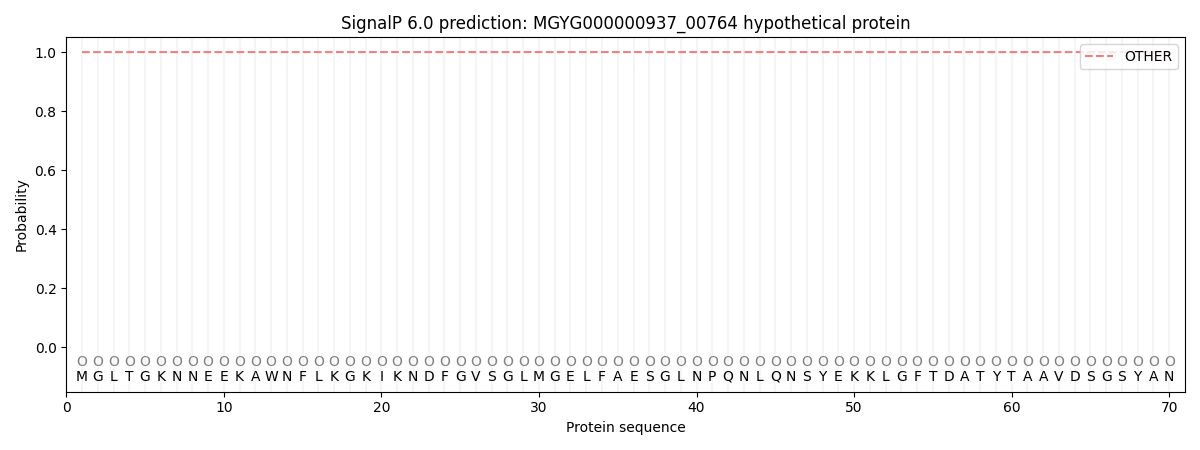You are browsing environment: HUMAN GUT
CAZyme Information: MGYG000000937_00764
You are here: Home > Sequence: MGYG000000937_00764
Basic Information |
Genomic context |
Full Sequence |
Enzyme annotations |
CAZy signature domains |
CDD domains |
CAZyme hits |
PDB hits |
Swiss-Prot hits |
SignalP and Lipop annotations |
TMHMM annotations
Basic Information help
| Species | UMGS403 sp900541975 | |||||||||||
|---|---|---|---|---|---|---|---|---|---|---|---|---|
| Lineage | Bacteria; Firmicutes_A; Clostridia; Oscillospirales; Acutalibacteraceae; UMGS403; UMGS403 sp900541975 | |||||||||||
| CAZyme ID | MGYG000000937_00764 | |||||||||||
| CAZy Family | GH25 | |||||||||||
| CAZyme Description | hypothetical protein | |||||||||||
| CAZyme Property |
|
|||||||||||
| Genome Property |
|
|||||||||||
| Gene Location | Start: 107130; End: 108653 Strand: + | |||||||||||
CDD Domains download full data without filtering help
| Cdd ID | Domain | E-Value | qStart | qEnd | sStart | sEnd | Domain Description |
|---|---|---|---|---|---|---|---|
| pfam18013 | Phage_lysozyme2 | 3.64e-27 | 7 | 170 | 1 | 139 | Phage tail lysozyme. This domain has a lysozyme like fold. It is found in the tail protein of various phages probably giving them the ability to degrade the host cell wall peptidoglycan layer. |
| pfam08230 | CW_7 | 9.20e-19 | 469 | 507 | 2 | 40 | CW_7 repeat. This domain was originally found in the C-terminal moiety of the Cpl-7 lysozyme encoded by the Streptococcus pneumoniae bacteriophage Cp-7. It is also found in the cell wall hydrolases of human and life-stock pathogens. CW_7 repeats make up a cell wall binding motif. |
| pfam01510 | Amidase_2 | 4.36e-15 | 208 | 343 | 2 | 121 | N-acetylmuramoyl-L-alanine amidase. This family includes zinc amidases that have N-acetylmuramoyl-L-alanine amidase activity EC:3.5.1.28. This enzyme domain cleaves the amide bond between N-acetylmuramoyl and L-amino acids in bacterial cell walls (preferentially: D-lactyl-L-Ala). The structure is known for the bacteriophage T7 structure and shows that two of the conserved histidines are zinc binding. |
| smart01095 | Cpl-7 | 5.61e-14 | 469 | 507 | 3 | 41 | Cpl-7 lysozyme C-terminal domain. This domain was originally found in the C-terminal moiety of the Cpl-7 lysozyme encoded by the Streptococcus pneumoniae bacteriophage Cp-7. It is assumed that these repeats represent cell wall binding motifs although no direct evidence has been obtained so far. |
| pfam05036 | SPOR | 2.06e-13 | 384 | 451 | 5 | 76 | Sporulation related domain. This 70 residue domain is composed of two 35 residue repeats found in proteins involved in sporulation and cell division such as FtsN, DedD, and CwlM. This domain is involved in binding peptidoglycan. Two tandem repeats fold into a pseudo-2-fold symmetric single-domain structure containing numerous contacts between the repeats. FtsN is an essential cell division protein with a simple bitopic topology, a short N-terminal cytoplasmic segment fused to a large carboxy periplasmic domain through a single transmembrane domain. These repeats lay at the periplasmic C-terminus. FtsN localizes to the septum ring complex. |
CAZyme Hits help
| Hit ID | E-Value | Query Start | Query End | Hit Start | Hit End |
|---|---|---|---|---|---|
| AFB75734.1 | 1.74e-186 | 1 | 367 | 1 | 369 |
| QUO22979.1 | 5.31e-183 | 1 | 367 | 1 | 369 |
| ADB89215.1 | 4.98e-77 | 183 | 361 | 9 | 190 |
| CBL18646.1 | 1.81e-74 | 186 | 363 | 6 | 184 |
| AFB76124.1 | 2.80e-53 | 182 | 361 | 3 | 180 |
Swiss-Prot Hits help
SignalP and Lipop Annotations help
This protein is predicted as OTHER

| Other | SP_Sec_SPI | LIPO_Sec_SPII | TAT_Tat_SPI | TATLIP_Sec_SPII | PILIN_Sec_SPIII |
|---|---|---|---|---|---|
| 1.000059 | 0.000000 | 0.000000 | 0.000000 | 0.000000 | 0.000000 |
